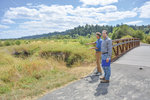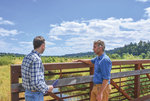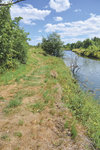


LA CENTER – With its abundance of wildlife, peaceful walking trails and views of the nearby East Fork Lewis River, the La Center Bottoms Wetlands area is already a popular attraction for wildlife lovers and visitors seeking an escape from the hustle and bustle of urban life.
In fact, the 166-acre wetlands, located near La Center’s Sternwheeler Park on 3,500 feet of East Fork Lewis River shoreline, is one of only three state-designated “Watchable Wildlife” sites in Clark County.
From the outside, the wetlands might appear to be thriving. But environmental scientists say the area is in need of an upgrade, and that returning the La Center Bottoms Wetlands to a more natural state will help the area attract even more birds, mammals, reptiles and – most importantly from an environmental standpoint – juvenile salmon looking for a shady spot to rest, cool down and snack on insects during their long journey toward the Columbia River.
“Historically, this site was well forested and had a connection to the river,” explains ecologist Marshall Johnson.
Johnson is a principal restoration ecologist for the Lower Columbia Estuary Partnership (LCEP), a Portland-based nonprofit supported by the U.S. Environmental Protection Agency as well as the states of Oregon and Washington and numerous public and private groups, that is committed to improving the health of the lower Columbia River estuary, which includes the East Fork Lewis River.
The LCEP has been working for three years on a plan that would restore the wetlands to a more natural state, while protecting the public trail and access points that La Center residents and visitors have come to count on.
The group’s focus is twofold. One part of project will reconnect the East Fork Lewis River with the wetlands through a series of meandering channels that replicate a more natural connection to the historic floodplains and offer hiding spots for salmon and other fish, as well as a seasonal watering hole for the various species of birds, reptiles and mammals that flock to the La Center Bottoms. The second portion of the project involves La Center students, mostly fourth- and fifth-graders, who will learn about wetlands ecology in the classroom and will help LCEP plant native trees and plants in the La Center Bottoms Wetlands area over the next few years.
“We’re taking the river back to a more dynamic interaction with the wetlands,” explains Chris Hathaway, LCEP’s deputy director. “Our primary focus is on the threatened or endangered species in the area. Restoring (the wetlands) to the more natural connection that the river used to have with this floodplain will help those species.”
Those natural connections were disrupted several generations ago, after the 1930s, when La Center residents decided to clear the land and use it for agricultural purposes. A levy was built to keep the river at bay and prevent the seasonal flooding of the wetlands area. In 1993, private owners sold the land to the county, which took the land into its protected Legacy Lands Program, and built a walking trail on top of the levy.
“Now, you can see that the levy is failing in some spots and the trail is in danger, too,” Johnson says, pointing to spots on the current walking trail where visitors can see that the river is cutting into the levy and eroding the trail from underneath.
The LCEP project will breach the levy in those weakened spots, build channels so the river can flow in and out of the wetlands, and shore up the walking trail with reinforced pedestrian bridges – a win-win for nature and humans, Johnson says.
As it stands now, the wetlands is connected to the East Fork Lewis River through one channel that is currently covered by a pedestrian bridge along the walking trail. The LCEP project will add three more river connections and reshape the channels leading out to the wetlands. Instead of the channels being a straight line like the current construction, the new channels will meander and twist in a more natural shape – providing ample spots for fish to hide from predators or take a break in the shade, explains Johnson. Planting native trees and shrubs along the channels will help suppress invasive grasses that now plague the area and will become a food source for the types of insects and other animals native to the area.
On July 22, the group released a Request for Bids (RFB) for the project, which is slated to begin the first week of September and be completed in just two months. After it is completed, visitors to the La Center Bottoms Wetlands trail will see four bridges instead of just one. And, while the three new bridges will be smaller than the current pedestrian walking bridge, Johnson says his group is using the same design firm, so the look will be cohesive.
The second part of the project, which will bring estuary science into the classrooms at La Center Elementary School and get hundreds of students into the local wetlands for native tree planting events, will begin this fall.